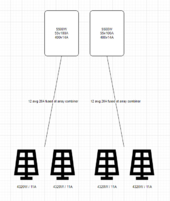hwy17
Anti-Solar Enthusiast
I am playing around with the concept of conductor over paneling that I just recently picked up from other discussions around here.
I was aware of charge controller over paneling, but it had not previously occurred to me that overpaneling could potentially also achieve an economy on conductor wire as well. It gets a little precarious and may require using fixed voltage power points rather than MPPT, to avoid the tracking mode ever searching into intolerable low voltage high amperage power points.
If you're wondering why not just spend a little money once on bigger conductors, that's valid. I am just exploring the idea.
Here is an example of 17kW PV feeding into 11kW of charge controllers on just 4 12 AWG conductors. I believe individual string fusing would not be necessary since there only two arrays in parallel on each charge controller. 20A fuses directly after the parallel array combiner or splice provide protection for the long run of 12AWG conductor, in case of short circuit or charge controller overcurrent.
Code wise, I'm not sure there would be any way to fully justify it under the NEC. Article 690 probably has too many definitive statements that ignore the possibility of this concept entirely.

I was aware of charge controller over paneling, but it had not previously occurred to me that overpaneling could potentially also achieve an economy on conductor wire as well. It gets a little precarious and may require using fixed voltage power points rather than MPPT, to avoid the tracking mode ever searching into intolerable low voltage high amperage power points.
If you're wondering why not just spend a little money once on bigger conductors, that's valid. I am just exploring the idea.
Here is an example of 17kW PV feeding into 11kW of charge controllers on just 4 12 AWG conductors. I believe individual string fusing would not be necessary since there only two arrays in parallel on each charge controller. 20A fuses directly after the parallel array combiner or splice provide protection for the long run of 12AWG conductor, in case of short circuit or charge controller overcurrent.
Code wise, I'm not sure there would be any way to fully justify it under the NEC. Article 690 probably has too many definitive statements that ignore the possibility of this concept entirely.



